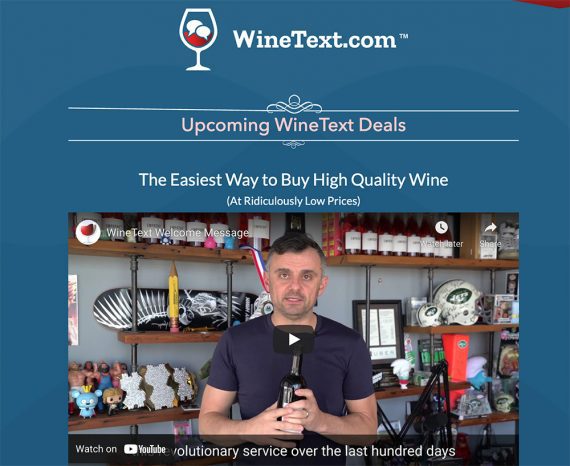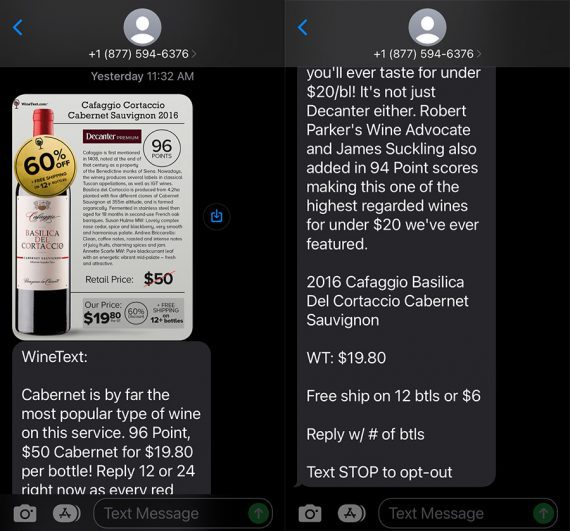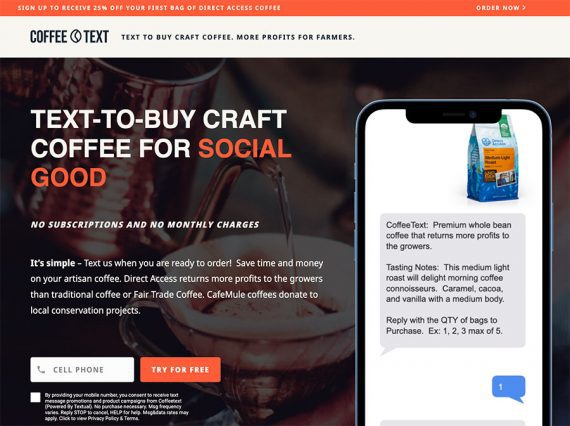Some ecommerce merchants obtain shoppers’ payment card information upfront and permission to send offers via text messages. It’s a way of developing customers while addressing marketing and fulfillment problems.
Entrepreneur and business guru Gary Vaynerchuk was among the first to use text messaging to sell products.
Wine Text
Vaynerchuk’s Wine Text claims to be “the easiest way to buy high-quality wine at ridiculously low prices.”

Wine Text is a discount discovery service that sends daily wine offers via text messages.
“The thesis of this incredible service, this revolutionary service…has been how do you spend two minutes to sign up — the address you’re shipping the wine to and the credit card you’re using — so that when you get the text daily, it takes two seconds,” said Vaynerchuk in a video posted on the Wine Text home page.
The concept is simple:
- Provide a text number.
- Enter a shipping address.
- Enter payment information.
- Receive regular text offers.

Shoppers reply to the Wine Text offer (at left) with the number of bottles to order.
Coffee Text
A similar service, Coffee Text, is a collaboration of an Idaho-based coffee roaster and Blu Atwood, the founder of Textual, a text-to-buy software company.
Once again, shoppers provide a shipping address and payment card information upfront. Then they enter a keyword via text such as “fuzzyears” or “midnightmule” to order a pound of their favorite coffee.

Coffee Text offers an easy way for shoppers to buy coffee.
Problems Addressed
This approach — get payment information upfront with communication permission — may address some of the problems ecommerce companies face in 2022.
It is becoming more expensive for many merchants to find customers.
Perhaps privacy-induced changes (from Apple and others) to behavioral ad targeting are to blame. Or it could be more competition. Shopify, for example, reportedly added 2.5 million merchants from March 2020 to January 2022.
To offset increased customer acquisition costs, ecommerce stores typically seek to increase customer lifetime value by earning more on each order or encouraging recurring buys.
The Wine Text and Coffee Text model addresses this problem. Both encourage consistent reordering and, for Wine Text specifically, bulk ordering, since Vaynerchuk’s service typically offers a discount or free shipping for buying multiple bottles.
Subscription Challenges
Subscriptions are an excellent way to solve the CAC-LTV problem described above, but enticing subscribers is not easy.
A consumer signing up for a subscription is making a long-term commitment. Sure, he can cancel at any time, but that requires action. He might recognize that one or two orders could slip through even after he has decided to stop. And this could cause him to hesitate before committing.
Signing up for a permission-to-sell service such as Wine Text or Coffee Text is less commitment. The buyer provides payment information but not immediate approval to be charged.
Direct Communication
The individual signing up for Wine Text or Coffee Text is also granting permission for the business to communicate with her directly via what might be her most important communication channel.
That level of direct access is rare.
Let’s compare it to email. Email marketing is a fabulous tool for ecommerce. But text messages are more intimate, at least for the moment.
It is not unusual for someone to have several email addresses that receive dozens, if not hundreds, of promotional messages a day.
Text messages are different. Most shoppers have one mobile number. They receive few, if any, promotional text messages.
Inventory Management
Wine Text does not offer fast delivery. A bottle of cabernet might not arrive for three weeks after purchase.
That could make inventory management easy.
Here’s how. A supplier could allocate, say, 1,000 units of a product to an ecommerce business, which has five days to confirm the quantity.
The business sends a text message to subscribers and sells 830 units. The business then orders only those 830 units. No guessing. No slow-moving inventory to hold later.
Applying the Concept
The concept of obtaining payment and shipping info in advance is not restricted to text messages. The goal is to reduce checkout friction and address communication and inventory hurdles. The model likely applies to other forms of dialog.
But it should address a customer’s need. Wine Text offers discounted prices and product discovery. Effectively, subscribers get a daily wine recommendation. Coffee Text is primarily a replenishment service. Both are valuable to consumers.
Getting started does not have to be complicated. Try it with a relatively small investment alongside your other ecommerce endeavors.




